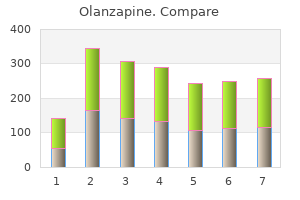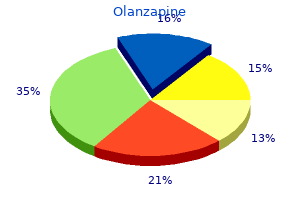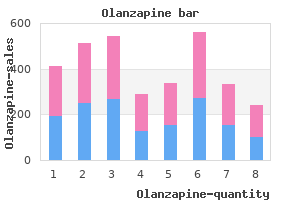Olanzapine
"Order 5 mg olanzapine overnight delivery, treatment internal hemorrhoids".
By: I. Ketil, MD
Associate Professor, Texas A&M Health Science Center College of Medicine
Proceedings of the seventy-eighth annual meeting of the American Radium Society medicine reactions order generic olanzapine pills, Paris daughter medicine order olanzapine line, France 7 medications that can cause incontinence generic olanzapine 2.5mg visa, April 29May 3 treatment plan for anxiety discount olanzapine online mastercard, 1995. A randomized trial comparing combination electron-beam radiation and chemotherapy with topical therapy in the initial treatment of mycosis fungoides. Combined modality therapy with electron-beam irradiation and systemic chemotherapy for cutaneous T-cell lymphomas. Combined modality therapy for tumor stage mycosis fungoides: results of a 10 year follow-up. Combined modality treatment of cutaneous T-cell lymphoma: results of a six year follow-up. Combined total body electron beam irradiation and chemotherapy for mycosis fungoides J Am Acad Dermatol 1987;16:45. Treatment of cutaneous T cell lymphoma by extracorporeal photochemotherapy: preliminary results. Mechanisms of lymphocytotoxicity induced by extracorporeal photochemotherapy for cutaneous T cell lymphoma. Recombinant leukocyte A interferon: an active agent in advanced cutaneous T-cell lymphomas. Clinical course of retrovirus-associated adult T-cell lymphoma in the United States. Treatment of adult T cell leukemia lymphoma with a combination of interferon alfa and zidovudine. Proceedings of the thirty-fifth annual meeting of the American Society of Hematology. Activity of fludarabine monophosphate in patients with advanced mycosis fungoides: a Southwest Oncology Group Study. T reatment of cutaneous T-cell lymphoma with a combination of low-dose interferon a2b and retinoids. Intramuscular low dose alpha-2B interferon and etretinate for treatment of mycosis fungoides. Correlations of unique clinical, immunotypic, and histologic findings in cutaneous gamma/delta T-cell lymphoma. Extent of skin involvement as a prognostic indicator of disease free and overall survival in T3 stage cutaneous T-cell lymphoma patients treated with total skin electron beam radiation therapy. Response of cutaneous T-cell lymphoma to therapy with hybridoma monoclonal antibody. The therapeutic role of interferons and monoclonal antibodies in cutaneous T-cell lymphomas. Therapy of chronic lymphocytic leukemia and cutaneous T-cell lymphoma with T101 monoclonal antibody. Monoclonal antibody T101 in T cell malignancies: a clinical pharmacokinetic and immunologic correlation. Infiltrative cell density in pre-irradiated skin as a prognostic factor in Mycosis Fungoides. Total skin electron beam therapy followed by adjuvant psoralen/ultraviolet A light in the management of patients with T1 and T2 cutaneous T-cell lymphoma (mycosis fungoides). Total skin electron beam therapy with or without topical nitrogen mustard or nitrogen mustard alone as initial treatment of T2 and T3 mycosis fungoides. Experience with total skin electron beam therapy in combination with extracorporeal photopheresis in the management of patients with erythrodermic (T4) mycosis fungoides.

Of importance treatment magazine olanzapine 7.5mg sale, a multivariate analysis of risk factors in the Rotterdam study showed that increasing age treatment myasthenia gravis buy olanzapine 7.5 mg, gender (male) symptoms 7 buy olanzapine in united states online, and a pretreatment cardiac medical history were significant for developing ischemic heart disease treatment degenerative disc disease order olanzapine 2.5mg fast delivery. It should be emphasized that the old breast irradiation techniques used in these particular studies delivered high doses of radiation to the heart. Long-term follow-up of patients in similar randomized trials who were treated with heart-sparing techniques did not show increased cardiovascular morbidity. However, higher doses of adjuvant doxorubicin were associated with a threefold to fourfold increased risk of cardiac events. This appears to be especially true in patients treated with higher dose volumes of cardiac irradiation. Lederman and associates 414 reported that patients with seminoma who received a relatively low dose of mediastinal irradiation (median, 24 Gy) had more ischemic heart disease compared with a similar group of patients whose mediastinums were not irradiated. It should be noted, however, that the observed cardiac risk in the irradiated group did not differ significantly from the expected risk of a comparable normal population. However, the value of routine noninvasive or invasive cardiac studies in asymptomatic patients has not been determined. Successful treatment of radiation-induced coronary disease with bypass surgery and with angioplasty has been reported. These findings provide a basis for future interventions that may decrease the risk of radiation-induced heart disease. The growing information about late cardiac effects should facilitate early diagnosis and therapeutic intervention for the benefit of previously treated patients. Pathophysiologic basis for cardiac monitoring in patients receiving anthracyclines. Adriamycin cardiotoxicity: endomyocardial biopsy evidence of enhancement by irradiation. Serial assessment of doxorubicin cardiotoxicity with quantitative radionuclide angiocardiography. Reversibility of severe left ventricular dysfunction due to doxorubicin cardiotoxicity. Functional myocardial impairment in children treated with anthracyclines for cancer. Doxorubicin cardiomyopathy: evaluation by phonocardiography, endomyocardial biopsy, and cardiac catheterization. The pathology of anthracycline cardiotoxicity in children, adolescents, and adults. Anthracycline-induced congestive heart failure in two pediatric leukemia cases and long-term follow-up. Cardiac failure and dysrhythmias 6-19 years after anthracycline therapy: a series of 15 patients. Clinical cardiotoxicity following anthracycline treatment for childhood Cancer: the Pediatric Oncology Group Experience. Long-term doxorubicin cardiotoxicity in childhood: non-invasive evaluation of the contractile state and diastolic filling. Cardiopulmonary evaluation of exercise tolerance after chest irradiation and anticancer chemotherapy in children and adolescents. Cardiac function following cardiotoxic therapy during childhood: assessing the damage. Prolongation of isovolumetric relaxation time as assessed by Doppler echocardiography predicts doxorubicin-induced systolic dysfunction in humans. Early detection of anthracycline cardiotocixity in children with acute leukemia using exercise-based echocardiography and Doppler echocardiography. Late effects of anthracycline therapy in childhood: evaluation and current therapy. Adaptation of cardiac contractile functions to conditions of chronic energy deficiency. Adriamycin: the role of lipid peroxidation in cardiac toxicity and tumor response. Adriamycin-induced free radical formation in the perfused rat heart: implications for cardiotoxicity.

Habitat and Distribution: Papaya is found in rain forests and semievergreen seasonal forests in tropical regions and in some temperate regions as well medicine for pink eye purchase on line olanzapine. Cook the young papaya leaves symptoms 8 weeks pregnant order olanzapine from india, flowers symptoms 0f a mini stroke order olanzapine visa, and stems carefully symptoms ebola buy generic olanzapine on-line, changing the water as for taro. Habitat and Distribution: these cacti are found throughout much of the desert regions of the western United States and parts of Central America. They are found throughout North America, Central America, much of the Caribbean region, North Africa, the Middle East, Europe, and some places in Asia. You can collect the young male cones, which grow only in the spring, as a survival food. If there is not enough resin on the tree, cut a notch in the bark so more sap will seep out. Habitat and Distribution: Look for these plants in lawns and along roads in the north temperate zone. Other Uses: To relieve pain from wounds and sores, wash and soak the entire plant for a short time and apply it to the injured area. To treat diarrhea, drink tea made from 28 grams (1 ounce) of the plant leaves boiled in 0. Habitat and Distribution: Look for this plant in open, sunny areas in forest clearings, in fields, and along roadsides in eastern North America, Central America, and the Caribbean. Never eat the underground portions of the plant as these contain the highest concentrations of the poisons. Do not eat any plant over 25 centimeters (10 inches) tall or when red is showing in the plant. Habitat and Distribution: this cactus is found in arid and semiarid regions and in dry, sandy areas of wetter regions throughout most of the United States and Central and South America. Some species are planted in arid and semiarid regions of other parts of the world. Habitat and Distribution: It grows in full sun in cultivated fields, field margins, and other weedy areas throughout the world. It has hooks on the midrib of its leaves that it uses to remain attached to the trees on which it grows. Habitat and Distribution: the rattan palm is found from tropical Africa through Asia to the East Indies and Australia. Edible Parts: Rattan palms hold a considerable amount of starch in their young stem tips. Other Uses: You can obtain large amounts of potable water by cutting the ends of the long stems (see Chapter 6). Habitat and Distribution: Look for reed in any open, wet area, especially one that has been disturbed through dredging. Reed is found throughout the temperate regions of both the Northern and Southern Hemispheres. You can also harvest them just before they produce flowers, then dry and beat them into flour. Soak the plant in water with some wood ashes to remove the bitterness; then dry, crush, and add it to milk or to other food. Rock tripes may contain large quantities of bitter substances; soaking or boiling the plant in several changes of water will remove the bitterness. When fresh, it has fluffy, yellowish-green flowers and red to purple egg-shaped fruit. It can also be found in a semiwild state in thickets, waste places, and secondary forests. It flourishes in damp lowlands in the Malay Peninsula, New Guinea, Indonesia, the Philippines, and adjacent islands. One trunk, cut just before it flowers, will yield enough sago to feed a person for 1 year.

Stereotactic radiosurgery plus whole brain radiotherapy versus radiotherapy alone for patients with multiple brain metastases medicine zanaflex olanzapine 5mg free shipping. Surgery and radiotherapy compared with gamma knife radiosurgery in the treatment of solitary cerebral metastases of small diameter symptoms liver cancer order generic olanzapine canada. Factors influencing survival after gamma knife radiosurgery for patients with single and multiple brain metastases symptoms 7 days post iui order on line olanzapine. Radiosurgery alone or in combination with whole-brain radiotherapy for brain metastases treatment 4 syphilis discount 5 mg olanzapine with visa. Stereotactic irradiation without whole brain irradiation for single brain metastases. Stereotactic radiosurgery for cerebral metastatic melanoma: factors affecting local disease control and survival. Gamma knife radiosurgery for metastatic melanoma: an analysis of survival, outcome, and complications. Interstitial irradiation of brain tumors using a miniature radiosurgery device: initial experience. The role of chemotherapy in the treatment of patients with brain metastases from solid tumors. Chemotherapy induces regression of brain metastases in breast carcinoma patients: update study. Front-line chemotherapy with cisplatin and etoposide for patients with brain metastases from breast carcinoma, nonsmall cell lung carcinoma, or malignant melanoma: a prospective study. Dose-intensive chemotherapy for breast cancer with brain metastases: a case series. Response of brain metastases from lung cancer to systemic chemotherapy with carboplatin and etoposide. Chemotherapy with cisplatin and tenoposide for cerebral metastases in non-small cell lung cancer. Tenoposide sometimes effective in brain metastases from non-small cell lung cancer. Is it time to reevaluate our approach to the treatment of brain metastases in patients with non-small cell lung cancer? Complete remission of a brain metastasis to third line hormonal treatment with megestrol acetate. Identification of prognostic factors in patients with brain metastases: a review of 1292 patients. The prognostic factors of lung cancer patients with brain metastases treated with radiotherapy. Identification of prognostic factors in patients with brain metastases: a review of 1292 patients. However, selected patients with metastases isolated to the lung may be resected safely and achieve prolonged survival compared to patients with unresectable metastases. In general, patients with complete resection of pulmonary metastases have associated prolonged survival (regardless of histology) compared to patients with unresectable metastases. This observation is surprising because surgery alone cannot control micrometastases. After complete resection of pulmonary metastases (including multiple and bilateral metastases), the long-term survival rate (more than 5 years) may be expected in approximately one-third of patients. The patient lived for several years after the surgery and died of recurrent disease. The first resections of a pulmonary metastasis as a separate procedure were described in 1926 by Divis 4 and in 1930 by Torek. Local control of the primary tumor was achieved, and the patient survived for 23 years after resection of the metastasis and died from unrelated causes. Alexander and Haight 7 reported the first large series (25 patients) of metastasectomy in 1947. Multiple metastases from osteochondroma of the tibia were resected in 1953 by Mannix, with the patient surviving more than 2 years. Since the late 1970s, resection of solitary and multiple pulmonary metastases from sarcomas and various other primary neoplasms have been performed with long-term survival in up to 40% of patients so treated. However, tomograms should be performed for evaluation of the extent of disease. Chest x-ray (posteroanterior and lateral views) of patient with multiple metastases from malignant fibrous histiocytoma.
5 mg olanzapine sale. Know the Signs of RSV: Help Keep Your Baby Out of the Hospital.

Cytotoxic T-lymphocyte response to cytomegalovirus after human allogeneic bone marrow transplantation: pattern of recovery and correlation with cytomegalovirus infection and disease medications osteoarthritis pain buy genuine olanzapine on line. Reconstitution of cellular immunity against cytomegalovirus in recipients of allogeneic bone marrow by transfer of T-cell clones from the donor 92507 treatment code buy olanzapine 2.5mg lowest price. Infusions of donor leukocytes to treat Epstein-Barr virus-associated lymphoproliferative disorders after allogeneic bone marrow transplantation treatment integrity checklist buy 7.5 mg olanzapine amex. Use of gene-modified virus-specific T lymphocytes to control Epstein-Barr-virus-related lymphoproliferation medications 123 generic 5mg olanzapine with amex. Long-term restoration of immunity against Epstein-Barr virus infection by adoptive transfer of gene-modified virus-specific T lymphocytes. The incidence and severity of nausea or vomiting in patients receiving chemotherapy varies, depending on the type of chemotherapy given, dose, schedule, combinations of medications, and individual characteristics. Approximately 70% to 80% of all patients who receive chemotherapy experience nausea and vomiting. In a 1993 study, 155 cancer patients receiving chemotherapy reported that they experienced an average of 20 physical and psychosocial symptoms: Nausea was ranked as the most severe symptom and vomiting as the fifth. Use of these new antiemetic agents has decreased the incidence and severity of nausea and vomiting induced by chemotherapy; however, these agents have not totally prevented the problems. The consequences of not controlling the nausea and vomiting induced by cancer treatment may lead to medical complications, a failure of the patient to comply with the cancer therapy and follow-up, and a diminished quality of life. Until recently, the neurotransmitter that appeared to be the most responsible for chemotherapy-induced nausea and vomiting was dopamine. Many effective antiemetics are dopamine antagonists that may bind specifically to the D 2receptor. However, there is a high degree of variation in dopamine receptor binding affinity by these drugs. H 1 antagonists alleviate nausea and vomiting induced by vestibular disorder and motion sickness but not nausea and vomiting induced by chemotherapy. High doses of naloxone augments emesis induced by chemotherapy, and low doses of narcotic may reduce emesis. Dexamethasone, which is a known effective antiemetic, may work by reducing arginine vasopressin levels. High-dose metoclopramide, unlike other D 2-receptor antagonists, has an exceptionally good capacity to decrease the emesis induced by cisplatin administration. The study revealed that cisplatin-induced emesis was totally blocked by this compound. After cisplatin administration, there is an increase in urinary excretion of 5-hydroxyindoleacetic acid, the main metabolite of serotonin, and this increase parallels the number of episodes of emesis. Most likely, the chemotherapy does not directly stimulate the peripheral receptors. It is known that patients who have a history of motion sickness experience a greater severity, frequency, and duration of nausea and vomiting from chemotherapy than patients who do not experience motion sickness. The mechanism by which the vestibular system may lead to chemotherapy-induced emesis is unknown; however, it is postulated that sensory information that is received by the vestibular system is different from information that was expected. Some chemotherapeutic agents, such as cisplatin or gallium nitrate, can lead to loss of taste sensation or to a metallic taste in the mouth. A study conducted with patients receiving chemotherapy for malignant melanoma revealed that patients developed a more intense sense of taste for sweet, bitter, sour, and salt. Changes in taste may contribute both to nausea and vomiting as well as to anorexia. Finally, chemotherapy-induced emesis may be induced by direct or indirect effects on the cerebral cortex. Animal studies have shown that nitrogen mustard partially causes emesis via direct stimulation of the cerebral cortex. It is also known that the amount of sleep before receiving chemotherapy may influence whether a patient develops chemotherapy-induced emesis. In addition, large differences exist in the severity and incidence of nausea and vomiting from the same chemotherapeutic agents in different countries. Aside from there being more than one mechanism by which each chemotherapeutic agent may induce emesis, chemotherapy induces emesis in a manner different from that of other classic emetic agents. Drugs such as apomorphine, levodopa, digitalis, pilocarpine, nicotine, and morphine cause vomiting almost immediately.

